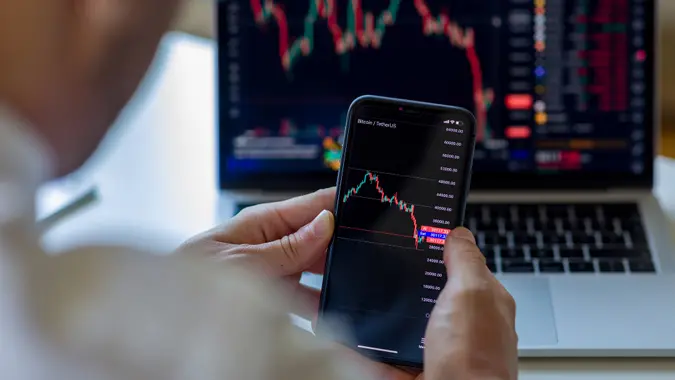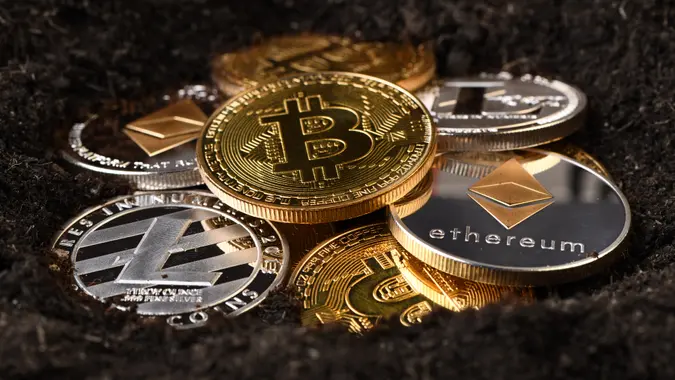What Is Polygon Blockchain? Your Guide

Commitment to Our Readers
GOBankingRates' editorial team is committed to bringing you unbiased reviews and information. We use data-driven methodologies to evaluate financial products and services - our reviews and ratings are not influenced by advertisers. You can read more about our editorial guidelines and our products and services review methodology.

20 Years
Helping You Live Richer

Reviewed
by Experts

Trusted by
Millions of Readers
Originally known as the Matic Network, polygon was created to scale ethereum and improve the infrastructure. It is an India-based project aiming to make transactions cheaper and quicker on the ethereum blockchain.
Keep Reading: 5 Subtly G
What Is Polygon?
Polygon is a layer two blockchain, meaning it is able to process crypto transactions more quickly and at a lower cost. Coinbase compares polygon to an express train. It is on the same track as all other trains but moves faster and makes fewer stops along the way. In this example, the track is ethereum, where polygon does a quicker job of fulfilling transactions than the ethereum blockchain.
The platform uses a proof-of-stake, or POS, consensus to secure the network and create new currency. Polygon has a market cap of 476.02 Million, and there are almost two billion polygon (MATIC) coins in circulation.
What Is MATIC?
MATIC is polygon’s native cryptocurrency — when the blockchain changed its name to polygon, it kept MATIC for its ticker.
How to Buy MATIC?
There are many cryptocurrency exchanges that sell MATIC. A few include:
Whichever exchange you choose, you’ll have to create an account and follow their instructions for buying MATIC.
How to Use Polygon
The coin serves a few purposes on the polygon blockchain:
- Governance: Those who hold MATIC can vote on changes to the blockchain.
- Staking: MATIC holders can stake their crypto on the blockchain to earn returns.
Fees: Polygon network fees are paid with MATIC.
FAQ
- What is the polygon blockchain and how does it work?
- Polygon is a layer 2 blockchain that uses the ethereum blockchain. However, it is faster and cheaper than ethereum.
- What is MATIC and what role does it play in the polygon network?
- MATIC is the native coin of Polygon. Those who hold MATIC get to vote on changes to the blockchain. They can also pay fees and stake.
- How do I buy MATIC and start using polygon?
- You can buy MATIC through a crypto exchange.
- Can polygon’s scalability really solve ethereum’s congestion issues?
- It is faster and cheaper than ethereum. However, a big hurdle is how many people and merchants will adopt this coin.
- Is MATIC a good investment for the long-term?
- All cryptocurrency is considered extremely volatile. It is only a good investment for people who have a high risk tolerance.
- What are the risks of using the polygon blockchain?
- Network congestion and bugs in smart contracts. This is similar to the risks of using ethereum.
Daria Uhlig contributed to the reporting for this article.
Our in-house research team and on-site financial experts work together to create content that’s accurate, impartial, and up to date. We fact-check every single statistic, quote and fact using trusted primary resources to make sure the information we provide is correct. You can learn more about GOBankingRates’ processes and standards in our editorial policy.
- CoinMarketCap. "Polygon."
- CoinDesk. "Binance, Kraken and Polygon Accelerate Hiring in Response to Industry-Wide Job Cuts."
- CryptoSlate. "Polygon on way to reaching mass adoption with major partnerships."
- Coinbase. "What is Polygon (MATIC)?"
- Cointelegraph. "Polygon blockchain explained: A beginner’s guide to MATIC."
- Blockchain Council. "Solana Vs. Polygon Vs. Ethereum – The Ultimate Comparison."
- Binance Academy. "Blockchain Layer 1 vs. Layer 2 Scaling Solutions."
- CryptEye "Polygon"
 Written by
Written by  Edited by
Edited by 

























